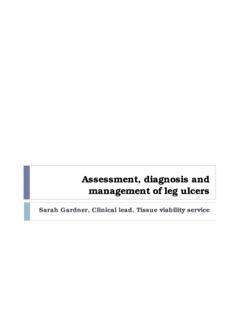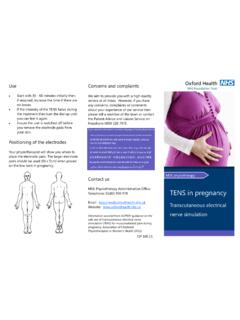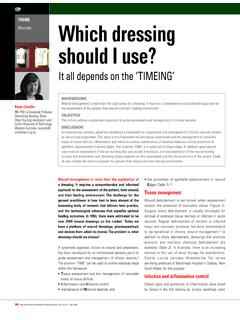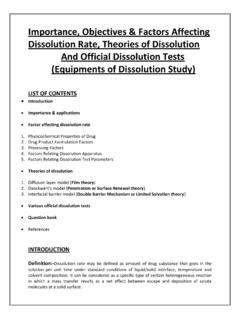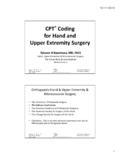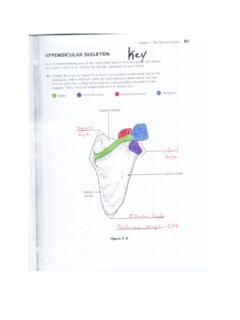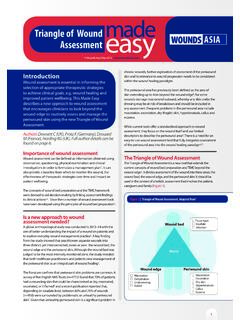Transcription of Wound Management - Oxford Health NHS Foundation Trust
1 Wound Management ADVICE & PRESCRIBING GUIDANCE 2015. Review Date 2018. CONTENTS. Wound Management Antimicrobial Formulary 23. Introduction 3 Topical Antimicrobial Dressing 23. Using this Formulary 4 First line option Medical Grade Honey 24. Actilite 24. Wound Categories Algivon Plus 24. Epithelialising 5. Algivon standard alginate 25. Clean/Granulating 5. Algivon Plus Ribbon 25. Sloughy 6. Medihoney Gel Sheet 26. Necrotic 6. Medihoney Antibacterial Wound Gel 26. Contaminated, Colonised or Infected 7. Reccomended 27. Fungating Malignant wounds 7. Managing Bleeding Fungating Wounds 8 Second Line Option Cadexomer Iodine Dressing 28. Dressings available from ONPOS. Iodosorb ointment 28. Dressing packs 9. Iodoflex Dressing 29. Contact layer 10. Perforated dressing with adherent border 10 RESTRICTED USE SECTION 30. Absorbent dressings 11 Alleyvn Life 30. Alginates 12 Proshield Plus 30.
2 Hydrocolloids 12 Debrisoft 31. Debridement 13 Adaptic touch 31. Films 13 Urgostart Contact 32. Surgical tape 14 UrgoTul 32. Sub-Bandage Wadding 14 Sorbion Sachet Multi Star 33. Retention bandages 14 Sorbion S Sachet Drainage 33. Tubular bandages 15 Larval Therapy 33. Bandage Compression 16 Silicone Gel Sheets 33. Negative Pressure Wound Therapy (NPWT) 34. Dressings Available on FP10. Charcoal Dressing 34. Skin Care Cleansing 17 3rd Line Antimicrobial Dressing Emollients 17 Cutimed Sorbact 34. Hydromol Ointment 18 Cutimed Sorbact Ribbon Gauze 35. Oilatum Cream 18 Cutimed Sorbact Swab 35. Balneum Cream 19 Cutimed Sorbact Gel 35. Hydromol Intensive 19 Acknowledgements 36. Balneum Plus Cream 20. Application of Emollients 20. Precautions 20. Fire hazard with paraffin-based emollients 21. Aqueous Cream 21. Barrier Creams 22. 2 Wound Management INTRODUCTION. T his formulary and clinical guideline was produced by the Oxfordshire Wound formulary group whose membership includes representatives from Oxfordshire monitored by the formulary group and support offered to clinicians in order to explore other alternatives.
3 We plan to update the formulary every 3 years, and CCG (medicines Management ), general practice and welcome comments and suggestions for improvement. Oxford Health (Tissue viability and Community nursing). The formulary will be held on both the CCG and It was approved by the Area Prescribing Committee Oxford Health 's clinical intranet sites. Oxfordshire (APCO) in March 2015. Education and training is offered across Oxfordshire This 2015 edition replaces the previous 2009/10 and will in relation to all aspects of tissue viability including the be only available as an electronic document which can selection of dressings and can be booked either through be downloaded and printed off if preferred. Please take the L&D portal ( Oxford Health staff). time to read through this document as there have been changes to some of the product categories. Or via Email: It is important that within the NHS we are able to Phone: 01865 902 734.
4 Justify our clinical decisions and expenditure on Wound The formulary group wish to thank the clinicians who Management products. In Oxfordshire we currently have supported the evaluation process over the past spend Million annually on dressings, bandages and 18 months in order for us to rationalise our product tapes; therefore this Wound Management formulary has inclusions. These have been representatives from been developed with the explicit aims of: community nurses, practice nurses, community hospitals, Promoting evidence based practice by providing a podiatry, older adult mental Health and children's framework within which it is safe to practice. services. Promoting continuity of care Promoting rational prescribing Other Considerations Encouraging safe, effective and appropriate use of Children dressings Children's skin is different and heals at different rates Promoting cost effectiveness to adults, and therefore whilst working predominantly Product selection should be based upon a within this product guidance, on occasion some comprehensive and holistic assessment of the patient children may need alternative dressings considered.
5 The and their Wound . Once the Wound aetiology and the Community Children's Nurses can be contacted for intended treatment outcome have been confirmed, an advice as they provide a county wide service. appropriate product can be selected. If a patients Wound Community Children's Nurse, fails to progress as expected then a referral to tissue Tel: 01865902700. viability should be considered. Secondary Care Links This formulary is designed to provide clinical staff with At present the products available within primary care a comprehensive guide to Wound dressings and have and secondary care differ. We are working hard to align been selected using available evidence gathered from prescribing aspirations with the subsequent availability a number of sources. This has included a review of the of products within the resources available, There has clinical evidence, local clinical evaluations and feedback been a Tissue Viability integrated working group set up of current usage.
6 Dressings in this formulary are for between Oxford Health and Oxford University Hospitals general use, with the exception of those that are Trust to promote strong links across the services. indicated as restricted use'. This category of dressings To contact the hospital tissue viability team email should only be prescribed following advice from Tissue Viability. The service can be contacted on either: Patients Requiring Specialist Podiatry input for Oxford Health staff ( Diabetic Patients). or, There may be different Wound care requirements for For TV Admin - Tel: 01865 904959 /904271. load bearing wounds, diabetic foot ulcers and the Fax - 01865-261757. arterial leg. We strongly urge you to seek specialist Prescribing outside this formulary must be justified by advice from podiatry or Tissue Viability in relation to specific patient need. Off formulary prescribing will be this group of patients.
7 Introduction 3. Using this formulary This formulary has been divided in to three categories: There are a number of symbols which provide specific information. These are: 1. Dressings that can be obtained from ONPOS - On line Non-Prescription Ordering Service Step Down 2. Dressings that require a prescription (FP10). This will show what options on the formulary 3. Dressings that are restricted' and require are available to step down to. approval from tissue viability first Step Up This will show what options are available to Dressings available from ONPOS step up to on the formulary if your current Non restricted dressings can be ordered using the PIN product is not clinically effective. numbers allocated to your teams. Orders should reflect the teams clinical case load/ Wound types. Cautions Please refer to the Best practice guidelines for Wound This show's you issues that may occur when formulary/ ONPOS use'.
8 Using this product. Dressings requiring a prescription Points to Consider These dressings do not require tissue viability approval Hints and tips about how to use the products. but a clear rationale for use should be documented within the patients notes. When requesting/ or prescribing these products please consider the following: For those clinicians who do not have access to ONPOS. The size of the Wound To avoid wastage, ensure (Community hospitals, in-patient mental Health wards) E. that the dressing matches the Wound size. procurement codes and PIP codes (prescription codes). have been provided to assist correct ordering. Treatment duration Calculate the number of dressings required for the planned treatment/. treatment objective ( A 2 week course of an antimicrobial). Do not over order. Repeat prescriptions Do not add dressings to a repeat prescription list. This contributes to stock piling Patient specific Dressings should not be prescribed (patient specific) if being added to a cupboard stock Restricted products For ONPOS users, the majority of products within the restricted category will be listed within the system.
9 Your order, however, will be blocked until you have liaised with tissue viability and a clear rationale provided for use. Requests should be patient specific and should form part of a clear plan of care. Tissue viability will be happy to support you in making these clinical decisions. For Non ONPOS users, please contact tissue viability on either or BEFORE dressings are prescribed in order to ensure that the request meets the criteria for use. 4 Wound Management Wound CATEGORIES. 1. Epithelialising Dressings should be non-adherent and maintain a LOW level of moisture at body temperature. NB. High Definition levels of moisture kept on epithelial tissue will cause a When the Wound is showing an evidence of a pink breakdown of these cells and begin the granulation stage margin to the Wound or isolated pink islands on the again and could cause over- granulation . Wound surface this is the start of epithelialisation.
10 Treatment Aim This usually happens once the granulation tissue is up to the level of the surrounding skin. The cells at the To complete healing edge multiply and begin to migrate into the injured process area. Uninjured hair follicles also act as islands of Prevent damage to epithelialisation. The tissue is pink to white in colour new epithelium. with a smooth surface appearance. 2. Clean and Granulating Heavily exuding granulating wounds potentially needs further investigation. Definition (Refer to the exudate pathway). granulation is the healing phase of tissue repair. New blood vessels are formed in the form of delicate loops Hypergranulation (Over- granulation ) Tissue of capillaries which have budded' away from the An abundance of granulation tissue that becomes proud damaged blood vessels in the Wound . These loops or protrudes from the Wound is commonly known as grow into and fill the Wound cavity.



